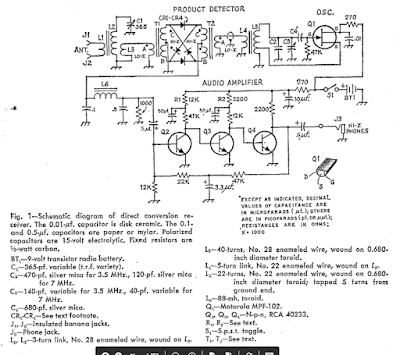Pavel CO7WT explained why Cuban hams used a process of thermal endurance to improved the frequency stability of their homebrew rigs: --------------------
I'm CO7WT from Cuba, I started my endeavor in ham radio with a islander board.
They (FRC, like ARRL but in Cuba) made a print of a PCB to build the Islander, with component numbers and values, making construction fool proof, I think it was on the 90 or end of the 80...
Mine was built with scraps from an old KRIM 218 Russian B&W TV as Coro's explain, later on I get the 6bz6 and 6be6 tubes for the receiver (this worked better than the Russian parts) the VFO was transistorized, made with Russian components. A friend CO7CO Amaury, explain me a trick: thermal endurance:
For a week put a crust of ice on the VFO board by placing it in a frosty fridge during the night. Put them in the sun by day. This indeed improved stability, this was an old trick.
By thermal endurance I
mean improving thermal resistance vs tolerance, meaning that tolerance doesn't
vary as much with temperature changes.
It's crazy, but it
worked!!
I remember that my vfo
was on 7 MHz, with Russian kt315 as normal Russian transistors and capacitors,
nothing 1-5%, 20% at most, it ran several khz in 5-10 min, mounted on a Russian
"Formica" board (no PCB) and wired underneath.
After that treatment to
the complete board with components and everything, including the variable
capacitor; I managed to get it to "only" noticeably in the ear after
30-40 minutes.
To me it was magic!!
Basically, what I'm
describing is just "thermal annealing", but Cuban-style and with more
extreme limits.
In a refrigerator you
could easily reach -10 c and in the sun for a day in Cuba 60-80 celsius at
least.
In Cuba in the
1990s-2010s many designs of DSB radios proliferated, both direct conversion and
super heterodine (using an intermediate frequency)
At first tubes and then
transistors, mostly using salvaged parts, so it was common to find 465/500 kHz
(if common Russian) 455 khz and 10.7 Mhz with or without "wide"
filters since narrow filters for SSBs were not scarce: they were almost impossible
to get.
Not only that, crystals,
ifs, PCBs, transistors, etc.
Then, around the 2000s,
Russian 500 khz USB filters began to appear (from Polosa, Karat, etc. equipment
from companies that deregistered and switched to amateur radio) and that
contributed to improving... Even though at 7 MHz 500kc if is very close.
I made many modifications with the years mostly from 1998 to 2004 ish... better filters in front of the first RX stage (same IF described between stages) improved selectivity and out of band rejection, remember we had on that days broadcast as low as 7100 khz
Tx part was a pair of russian 6P7 (eq. RCA 807) in paralell, etc.
The Jagüey and others is
one of those evolutions...
This is something I
remember...
73 CO7WT
----------------
This is not as crazy as it sounds. We can find versions of the same technique in the writings of Roy Lewellan W7EL, Doug DeMaw W1FB, and Wes Hayward W7ZOI. I found this 2007 message from our friend Farhan VU2ESE:
I think the word 'annealing' is a bit of a misnomer. the idea is to thermally expand and contract the wiring a few times to relieve any mechanical stresses in the coil. after an extreme swing of tempuratures, the winding will be more settled.
this techniques owes itself to w7EL. I first read about it in his article on the 'Optimized transceiver' pulished in 1992 or so.
but all said and done, it is part of the lore. it needs a rigorous proof.
- farhan
https://groups.io/g/BITX20/topic/copper_wire_annealing/4101565?p=,,,20,0,0,0::recentpostdate/sticky,,,20,1,860,4101565,previd%3D1193595376000000000,nextid%3D1194269624000000000&previd=1193595376000000000&nextid=1194269624000000000
And here is another example of coil boiling:
https://www.qsl.net/kd7rem/vfo.htm
-----------
I can almost hear it, all the way from across the continent: Pete N6QW should, please, stop chuckling. Obviously these stabilization techniques are not necessary with his beloved Si5351. Some will see all this as evidence of the barbarity and backwardness of LC VFOs. But I see it as another example of lore, of art in the science of radio. (Even the FCC regs talk about "Advancing the radio art." ) This is sort of like the rules we follow for LC VFO stability: keep the frequency low, use NP0 or silver mica caps, use air core inductors, keep lead length short, and pay attention to mechanical stability. Sure, you don't have to do any of this with an Si5351. Then again, you don't have to do any of this to achieve stability in an Iphone. But there is NO SOUL in an Iphone, nor in an Si5351. Give me a Harley, a Colpitts, or a Pierce any day. But as I try to remember, this is a hobby. Some people like digital VFOs. "To each, his own."
Thanks Pavel.
























